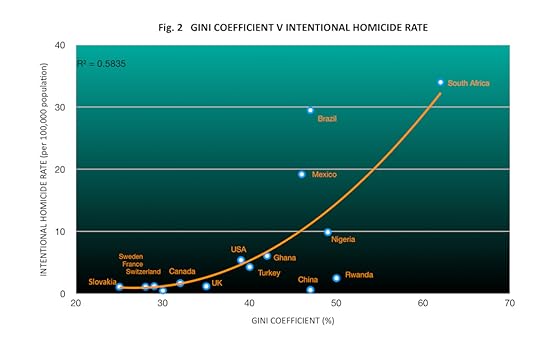Kwei Quartey's Blog, page 3
April 22, 2019
AFRICA’S GREATEST UNSOLVED MURDERS-4
AFRICA’S GREATEST UNSOLVED MURDERS-4
The US has its share of cold cases, unsolved murders, and murder mysteries that have never been cracked, but there’s murder in Africa too and in this series we are looking at some of Africa’s greatest unsolved murders. In the last blog, we saw a case from Ghana, West Africa. We will stay in the same region for this episode.

AFRICA’S GREATEST UNSOLVED MURDERS: Nigeria (Source: Ubakia)
BIBLE AND BLOOD
Eunice Olawale (“Oh-la-wa-lay”) was a deaconess of the Divine Touch Paris of the Redeemed Christian Church of God in Abuja, the federal capital of Nigeria. Murdered in 2016 at the age of only 42, her killing was particularly brutal, brazen and ignominious. Hers is only one of thousands upon thousands of homicides in Nigeria, which has a bad name for crime and an intentional homicide rate was 9.85/100,000 in 2015 by WHO estimate (for comparison, that of the US was 5.35 in 2016). The US Department of State has a travel advisory for Nigeria, and foreigners are warned that they may be targeted by violence.
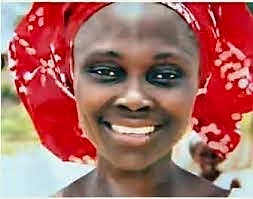
AFRICA’S GREATEST UNSOLVED MURDERS: Eunice Olawale portrait (Photo: Informationng.com)
By accounts, Eunice was humble, caring, and passionate about her faith and spreading its word.
What happened?
Eunice had the custom of leaving her home in Kubwa outside Abuja at around 5 AM to evangelize on the streets of Abuja, a practice called the “morning cry” in Nigeria. As always, she used a megaphone to be heard clearly above the hubbub of people and traffic. Preaching in this fashion is quite common in some West African cities, where Christian piety is taken very seriously.
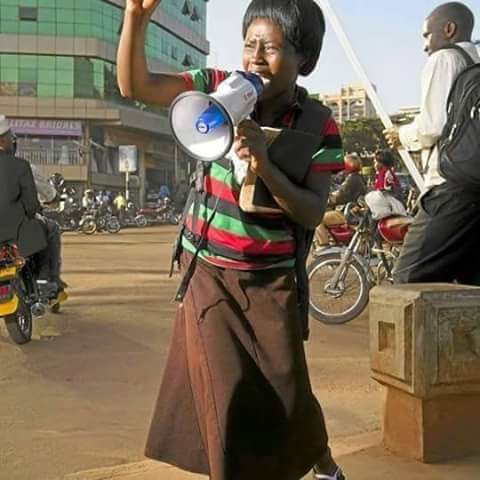
AFRICA’S GREATEST UNSOLVED MURDERS: Eunice Olawale preaching (“morning cry”) [Photo: Nigeria Gists]
Perhaps taking advantage of the relative darkness and solitude at that hour of the morning, Eunice’s attackers stabbed her in the abdomen and thigh, and slit her throat. Online news sites showing photos alleged to be Eunice lying in a pool of blood with her white megaphone and Bible beside her don’t confirm the decapitation. It’s unclear how long she lay there before the police arrived. For the dignity of the victim posthumously, I will not reproduce that photo here.
The grim news soon reached Eunice’s husband, Pastor Olawale. “I went to the station with my children,” Mr. Olawale recounted, “and when we got there, I saw the lifeless body of my wife at the back of the police van . . . from there, she was taken to the mortuary.” Other accounts claiming that Eunice had been decapitated were refuted by the Commissioner of Police, who stated the body was intact. That would correspond to the online photo alleged to be the victim (see above.)
The suspects
Suspicion initially fell upon an Imam in the area who reportedly asked a bunch of young Muslim men to chase Eunice Olawale away from her preaching spot. Although the Imam confesses to that, he denies ever telling the men to kill the evangelist. Several days before Eunice’s murder, she reportedly overheard Muslims in a mosque behind her home making hostile comments about her preaching, and that it wasn’t the “true word of God.”
Six potential suspects, including the Imam, were arrested amid official declarations that Eunice’s killers would be “brought to justice.” Nothing came of those arrests however. In fact, 2 years after Eunice’s death, the family were still appealing for justice to be done.
The bigger picture
First, if indeed Eunice’s death was as a result of religious violence in Nigeria, it is just one of many examples. After all, the radical Islamic group, Boko Haram, is based in Northeastern Nigeria. Christian-Islam conflict dates back to the mid-twentieth century.
Second, the evangelist’s murder occurred in a milieu of little or no modern police investigation. For CSI enthusiasts, you can be pretty much assured that no crime scene preservation was carried out by the Kubwa Police. All accounts indicate that Eunice’s body was picked up and that was the end of that. Crime in Nigeria is way ahead of law enforcement, which, plagued with low salaries and corruption, can barely stand up to the huge Nigerian population. The present policing system is overburdened, overstretched, and ill-equipped. There is a pervasive lack of forensic techniques in crime-solving. See my previous article about how Ghana rose above a similar status and made improvements in homicide investigation.
The list of unsolved murders in Nigeria, many of them political, is long. The task of modernizing and transforming the police force in Nigeria is a monumental one. The saddest part, of course, is that although Nigeria is rich in oil and West Africa’s biggest economy, little of that wealth benefits the country as a whole. The inequality gap is wide and severe, with the net worth of just five Nigerian millionaires equal to about $30 billion. Only Norway seems to know how to make oil an equitable business.
The post AFRICA’S GREATEST UNSOLVED MURDERS-4 appeared first on Kwei Quartey.
March 19, 2019
AFRICA’S GREATEST UNSOLVED MURDERS-3
AFRICA’S GREATEST UNSOLVED MURDERS
The US has its share of cold cases, unsolved murders, and murder mysteries that have never been cracked, but there’s murder in Africa too. In the last blog, we saw a case from Kenya, East Africa, and before that, South Africa. Now we move to Ghana, West Africa, where the mystery of “The Accra Strangler” went unsolved for years. It might well have permanently become one of Africa’s greatest unsolved murders were it not for a combination of fortunate events.
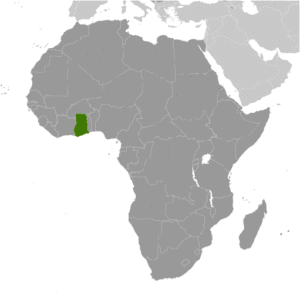
AFRICA’S GREATEST UNSOLVED MURDERS: GHANA, WEST AFRICA
THE ACCRA STRANGLER
From 1993 to 2000, more than thirty women were murdered in and around Accra, Ghana’s capital, and Kumasi, Ghana’s second-largest city. All bore the chilling signs of a repeat offender whose MO was to attack his victims (food sellers or sex workers) between 8 PM and dawn, rape them, and strangle them to death. The women were found stripped from the waist down with their legs drawn apart. In many cases unused condoms had been scattered around the crime scene, and some of the victims had their genitals mutilated. Bizarrely, empty syringes had been left at the scene and some victims had needle pricks where their blood had been drawn (or at least attempted). This set of killings came to be known as the Mataheko (“Mah-tah-hay-koh”) Murders, named after the area in which they occurred, although most of them took place in an adjoining suburb, Dansoman.

AFRICA’S GREATEST UNSOLVED MURDERS: DISTRIBUTION OF MATAHEKO MURDERS (Google Maps, annotation by Kwei Quartey)
A scared, angry community
Two such gruesome murders occurred within a week of each other on September 24 and October 1, 2000. On December 22, 2000, an angry street protest demanded the resignation of the Minister of Interior and the then Inspector General of Police. (The IGP was replaced a few months later, and the minister was voted out of office at the next election.)
By the end of 2000, the pressure on the police to find Accra’s serial killer had become inexorable. The accusation leveled at the police authorities was that they had failed to take the string of killings seriously and thus the situation had grown completely out of control. The police countered they were under-resourced and overloaded, which anyone who has familiarity with the Ghana Police Service (GPS) knows was and still is accurate. But quite apart from that fact, the authorities had no coordinated, logical approach to catching the killer.
A fortuitous meeting
In 2000, John Kufuor of the New Patriotic Party won Ghana’s general election to become the president of Ghana. One of his campaign pledges was to commit to greater public safety, which included stopping the rampant serial murders that had gripped Accra. In April of 2001, Louis Freeh, the then Director of the FBI, stopped in Accra on his way to the Africa/Middle East Chapter of the FBI National Academy Associates Retraining Session in Cape Town, South Africa. It was the first visit to Ghana by an FBI director. During talks between the country’s top officials and Freeh, President Kufuor told the FBI director about the spate of killings in the country and he requested assistance to solve them. Freeh promised he would have an FBI team in Ghana within 10 days.
The FBI encounters a lack of competent investigation
True to his word, within 10 days, Freeh sent out a team of seven FBI agents to Ghana—four from the Critical Incident Response Group‘s Child Abduction & Serial Killer Unit, two from the Evidence Response Team Unit (ERTU) in the Washington, DC field office, and one polygraph expert from the Atlanta division. Gerard Downes, a talented and versatile FBI Special Agent, led the team, which arrived in Accra to find the Ghana Police Service (GPS) awash with unsolved homicides and no strategy to crack them.
Downes was faced with a police force largely untrained in murder investigation, but ready and eager to learn. Downes and the Ghanaian authorities got together to organize training sessions for the police officers, who, according to Downes, were rapt with attention and hungry for knowledge. One of the first lessons was the use of a pin map showing the location of murders, part of a technique called geographic profiling. Another was the neighborhood canvass. In fact, in this investigation, the canvass was the major factor in breaking the case. Without solicitation by the FBI team, a single name came up repeatedly in each of the first four canvasses: Charles Quansah, a man eyewitnesses had seen in the vicinity of the victims’ last sighting.
A Man Called Quansah
In 1986, 18-year-old Charles Ebo Quansah was convicted of the rape of a Dansoman woman and sentenced to nine months hard labor. But once a rapist, always a rapist, and only 3 months after Quansah’s release, police arrested him again for the same crime. A news source says he was sentenced in 1987 to 3 years at the medium-security Nsawam Prisons. While serving his time, Quansah met a fellow prisoner called John Bita (also written as “William Bittar” in some accounts), who taught him some carpentry (vocational training is/was available at Nsawam) and helped him find a job at a lumber yard in Kumasi, Ghana’s second largest city.

GREATEST AFRICAN UNSOLVED MURDERS: Charles Quansah (Photo courtesy FBI agent Gerry Downes & jerriwilliams.com)
The confession: how the FBI pulled it together
The GPS Criminal Investigation Department had preserved very little physical evidence from the murder cases. One notable exception was a bloody T-shirt a woman had brought to the police. She told them that Quansah was her boyfriend and that he had been away from home at the time of the last killing. When he returned, his T-shirt was bloody.
What the GPS did have were some good photographs of the victims and the associated crime scenes. Upon reviewing them, Downes and his team were confident that the murders had enough behavioral similarities to indicate they had been committed by the same offender. With Quansah’s name having consistently popped up during the canvass, Downes and the team asked the GPS to bring him in for questioning. Just to correct the record, Quansah’s arrest took place in April 2001, not in 2000 as often reported.
Initially, Quansah denied any involvement in the Mataheko killings or any others. The FBI team then polygraphed Quansah, something that had never been done before in the GPS. It proved easier said than done because the questions had to be relayed through an interpreter in order to accommodate Quansah speaking in his mother tongue. At any rate, the polygraph showed him to be deceptive.
The FBI team confronted Quansah with the polygraph results and then questioned him using a technique in which moral justifications (themes) are thrown out by the interviewer. Quansah latched onto one particular theme, finally blurting out that “the spirits” had made him commit murder. In the subsequent two days, the FBI polygrapher with the interpreter secured Quansah’s confessions to the murder of nine women, included a maid in his home when he had lived in Kumasi.
Downes and his team prepared the Ghanaian detectives for the remaining interviews, coaching them on the approach that promised the best results. Indeed, the subsequent interrogations by the Ghanaian detectives unveiled Quansah’s culpability in as many as thirty murders or more. He knew details about the victims that had never been revealed to the public and confirmed that many of them had been prostitutes. His MO was to befriend vulnerable women at night, strangle them to death after raping them, and then pose them in degrading postures, a practice common among serial killers worldwide. According to Downes, the FBI’s Quantico forensic lab detected Quansah’s DNA on the bloody T-shirt along with the victim’s blood.
The trial and sentence
On August 7, 2002, Quansah was convicted of the murder of nine women and sentenced to death by hanging. In practice, the death penalty in Ghana is rarely carried out, and the last execution was in 1993. Thus, Quansah continues to languish in prison, where he abruptly retracted his confessions and claimed innocence soon after conviction. In November 2002, he filed an appeal against his sentence in September, 2002. In 2005 and again in 2007, he was apparently still working on his appeal, even soliciting the aid of a penpal in Holland. There’s no information on this “relationship” that I can find apart from the letter below from Quansah to “Kamiel.”

AFRICA’S GREATEST UNSOLVED MURDERS: CHARLES QUANSAH’S LETTER TO A PENPAL IN HOLLAND (Courtesy Murderauction.com)
But incredibly, by 2010, the appeal had not yet been heard by the court because Quansah’s case docket couldn’t be located. Quansah continued to steadfastly claim he was coerced into confession and alleges he was tortured to that end. The police have flatly denied this. Note that the nine murders for which Quansah was convicted were probably those with the strongest witness corroboration, but some 30+ in total in Accra were ascribed to him, and another possible ten in Kumasi. Therefore, Quansah was prolific as a serial offender, even by world standards. He is Ghana’s only serial killer that we know of.
Long-term repercussions–good news
The reign of Charles Quansah’s murderous activity did have one very salutary result. Once the contact had been made between the FBI and Ghanaian authorities, at least three of Ghana’s top police officers gained admission to the FBI National Academy training course including David Asante-Apeatu, Ghana’s present Inspector General of Police (IGP). Under him, great strides have been made in the modernization of the force—still with a way to go, of course.
In a remarkable full circle, Gerry Downes was invited in 2007 to return to Ghana, which was hosting the annual Africa/Middle East FBI National Academy Associates Retraining Session that Louis Freeh had attended in 2001 in Cape Town. This time, it was in Accra. On his visit, Downes was impressed and gratified by the degree of progress within the GPS. To quote Downes directly, “It was just an amazing thing to see the way they had developed into a good police agency.” He felt proud to be a part of it.
Acknowledgements
My sincere thanks to retired FBI Special Agent Jerri Williams for her assistance personally and via her excellent website and podcast, with which every true crime enthusiast should become familiar. Many thanks also to retired FBI Special Agent Gerard Downes for his patience with the questions I had for him.
AFRICA’S GREATEST UNSOLVED MURDERS: GHANA
The post AFRICA’S GREATEST UNSOLVED MURDERS-3 appeared first on Kwei Quartey.
March 8, 2019
AFRICA’S GREATEST UNSOLVED MURDERS-2
AFRICA’S GREATEST UNSOLVED MURDERS-2
The US has its share of murder mysteries that have never been cracked, but in this series, we’ll examine Africa‘s greatest unsolved murders. These are cases in which the perpetrators have never been found, or if they have, multiple questions remain unanswered.
The previous blog in this series talked about an apartheid-era killing in South Africa. Now we move to KENYA, East Africa.
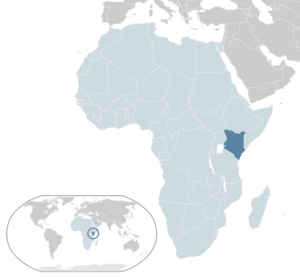
AFRICA’S GREATEST UNSOLVED MURDERS: Kenya (Wikimedia)
MURDER ON VALENTINE’S DAY: BEAUTY AND CELEBRITY
Careen Chepchumba was a 26-year-old, vivacious young Kenyan who worked for Kenya Power in Nairobi. On Sunday, February 12, 2012, her brother Emmanuel Kiptoo dropped her off at her upscale apartment in Santonia Court, a gated community in the posh Kilimani neighborhood.

AFRICA’S GREATEST UNSOLVED MURDERS-2: Careen Chepchumba (Photo: The Star, Kenya)
On Monday, Emmanuel tried but failed to reach Careen by phone. One news account states that subsequently, “he [Emmanuel] said their mother asked him to drive her to his sister’s apartment to check on her.” That seems to imply that Emmanuel and his mother went to the apartment the same day, Monday the 13th, the day before Valentine’s. Nevertheless, most accounts confirm that it was February 14th that the awful discovery was made.
There was no response to Emmanuel’s knocking on Careen’s apartment door. To his surprise, the door was open and so he entered, noticing two things: first that Careen’s sandals were at the door, suggesting she was home, and second, two used wine glasses were in the kitchen sink as he went past. Music was playing, but Careen was in bed with her laptop at the bedside. Emmanuel said he thought “she was sleeping.” (It seems odd that he wouldn’t have checked to be sure she was okay, given an unlocked door, two wine glasses and so on. In that circumstance, many would have felt that something was not quite right.)
Emmanuel returned to the car, where his mother was waiting, and they went back to Careen’s apartment together. Emmanuel’s mother started opening some windows because the room was “stuffy,” and then she went to Careen’s bedroom, shortly after which Emmanuel heard his mother screaming as she realized Careen was dead. Her autopsy would show that “death was due to lack of oxygen due to manual strangulation.” The pathologist reported that the force exerted on Careen’s throat had caused hemorrhage from her eyes and into her neck muscles.
Who had motive?
In considering possible motive, attention turned immediately to a man called Louis Otieno. This was no ordinary Joe. Otieno was one of Kenya Television Network‘s (KTN’s) most successful and high-profile TV anchors, known for his eloquence and hard-hitting interviews.
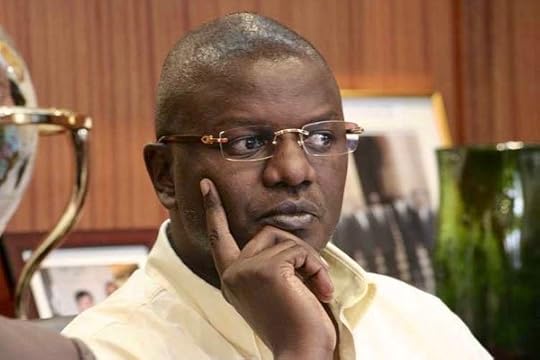
AFRICA’S GREATEST UNSOLVED MURDERS-2: Louis Otieno (Photo: Phoebe Okall/ Nation Media Group)
However, a darker reputation haunted Otieno. Media reported his love of a lavish lifestyle with fancy cars, spending sprees, alcohol, and glamorous women. If this was the case, then it was a familiar story of becoming too rich, too young and foolishly squandering one’s earnings. I wasn’t able to put Otieno’s meeting Careen on a timeline in relation to his financial woes, but certainly by late 2011, Otieno was in serious trouble and turned to Careen for help. To support him, she reportedly borrowed heavily from family and business partners to the tune of 4.2 million Kenyan shillings, about $42,000. Some of this money she obtained under pretext, suggesting Otieno was heavily pressuring her to obtain the cash.
What was all that money for? Answering that question was the purpose of Careen’s father calling an “emergency” family meeting on Sunday February 12, 2012–perhaps a confrontation of sorts–in which Careen admitted to family that she had been paying Otieno’s rent, medical bills, and his children’s school fees. Otieno had two children from a first marriage. Careen was also paying for Otieno’s expensive taste in cigars.
The February 12 meeting, at which a chastised Careen agreed to drastic measures to pay back the money she owed, must have marked the pinnacle of the crisis with Otieno, because the police reported that on February 6, Careen had written a note to her father expressing remorse for having entered into a relationship with Otieno. She also apparently wrote, or started to write, a note to her father on February 12, but for some reason, she tore it up and put it in her bedroom trash bin.
Was Careen a case of a young, smitten woman falling into a relationship with a celebrity only to realize, too late, that she was trapped in a hornets’ nest with no escape? On occasion, she had denied being anything more than a “friend” of Otieno’s, but her family and a close friend, Paul Ng’ang’a, stated that she was having a full-blown romantic relationship with him. Clearly, something went terribly wrong to the point that Careen, just before she was murdered, had been about to file an extortion claim with the police and get a restraining order for Otieno not to visit or call her. It had taken her a while to realize how much she had been used by Otieno, but she was seeing it now.
A bungled investigation
Clearly, Careen was pulling away from her lover just before her death. This could be the classic case of, “If I can’t have you, no one else will,” one of the strongest motives around for murder. The inquest into Careen’s death was, incredibly, delayed for 4 years, and the case was still open and at an impasse as recently as 2018. At the inquest, the judge ruled that the police had bungled the case, making it impossible to arrest and convict anyone.
It appears that DNA testing of possible suspects was never done. The chief government pathologist thought Careen might have been sexually assaulted by the assailant. “We took samples for further analysis but I have never seen the report,” he said. The samples were supposedly handed over to the detectives at Kilimani Police Station, but no one seems to know what happened to the samples after that.
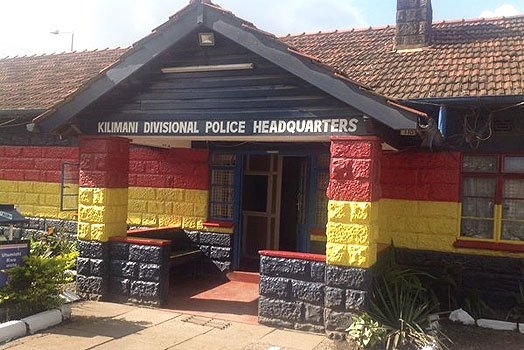
AFRICA’S GREATEST UNSOLVED MURDERS-2: The colorful Kilimani Police Station, slated to be replaced with a more modern, larger facility (Photo: The Star, Kenya)
So, here are some of the major unanswered questions (there are probably many more):
What about the two wine glasses in Careen’s kitchen sink? Glass is a gold mine for fingerprints and there might have been DNA as well.
Otieno’s nail clippings were not tested for DNA. It turned out that the clippings obtained were Careen’s and not Otieno’s –a clerical error or mixup in the chain of custody, perhaps. Still, Careen’s nail clippings could have been tested against samples from possible suspects with whom Careen might have struggled as she was being strangled.
Questioned, Careen’s friend Mr. Ng’ang’a said Louis Otieno often “sneaked” into Careen’s Santonia Court apartment. This corroborates what one of the security guards at the apartment complex reported. According to him, Careen had instructed him to give Louis Otieno unrestricted access to her.
A taxi driver called Samuel Gacheru was a kind of gofer for Careen. He sometimes took her shopping, and on other occasions he went to the airport to pick up packages for her, including Otieno’s costly cigars. Careen owed Gacheru money as well! On February 14, he had texted Careen to remind her to pay up. The prosecutors alleged also that Gacheru made a 17-second call to Careen the day she was killed. All this is murky. What’s the taxi driver’s story? Did he have a crush on Careen? Was his alibi explored?
On the face of it, all the above speaks of incompetence to such an egregious degree that it makes one speculate whether there was a coverup. In some ways, Louis Otieno seems to have been calling the shots, e.g. refusing to do a DNA test, and securing the exoneration of the police authorities even before they had carried out any mobile phone forensics. An inquest four years after the event seems an excessive period, and with this passage of time, resolution of the case seems more and more remote as a possibility.
The decline, fall, and rise again of a celebrity?
Louis Otieno’s glorious past is exactly that–past. It could be said that it began as a falling-out with the KTN editors and crew as Otieno became arrogant, egotistic, and short-tempered. But his fall became more precipitous once the scandal and murder of Careen Chepchumba broke. In 2014, Otieno was admitted to the hospital with acute pancreatitis, likely as a result of alcohol abuse. He subsequently lost his hearing, a rare complication of pancreatitis, as well as suffering a loss of balance and difficulty walking (ataxia). The medical details are complex and beyond our scope here. Otieno, all but penniless, crowdfunded enough money, about $40,000, for a cochlear implant. The surgery was performed in Nairobi in 2018 and appears to have been successful. Otieno’s deafness had been a major cause of his depression. Will restoration of his hearing set him on a path to a reinvigorated life? We don’t know, but meanwhile, Careen is still dead. What will happen to the investigation into her murder? We don’t know that either, but the prospects do not look good.
The post AFRICA’S GREATEST UNSOLVED MURDERS-2 appeared first on Kwei Quartey.
February 27, 2019
AFRICA’S GREATEST UNSOLVED MURDERS
AFRICA’S GREATEST UNSOLVED MURDERS
The US has its greatest unsolved murders, but the continent of Africa has also had its own high-profile cases that have never been settled. In this series, we’ll examine the greatest unsolved murders on the continent of Africa. These are cases in which the perpetrators have never been found, or if they have, multiple questions remain unanswered.
Chapter One
The Murder of Robert and Jeanne Smit: an apartheid-era killing (South Africa)
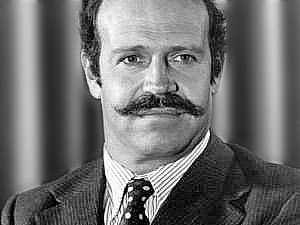
AFRICA’S GREATEST UNSOLVED MURDERS: Robert Smit (Photo: flatnote.co.za/foto24)
The evening of 22 November 1977 was a fateful one for prominent political couple Robert Van Schalkwyk Smit and wife Jeanne-Cora. Robert and Jeanne were shot and stabbed to death at their home that night but at different points in time. She was the first victim as she waited for husband to return home from work, and the same brutal end awaited him when he later arrived and opened the front door of the house.
Forty-two years later, the murder has never been solved and questions continue to swirl. Liza, the Smits’ daughter, who was only 13 years old at the time of her parents’ death, has written a kind of memoir/truth-seeking book, I Am Liza Smit, that names a number of suspects–even strong ones–but no one was ever definitively tied to the murder and no arrests were ever made.
Who were the Smits?
Robert Smit was a member of South Africa’s National Party (NP), an Afrikaner party that existed from 1914 to 1997. Afrikaners are descended from South African’s Dutch settlers of the 17th and 18th century. The NP promoted Afrikaner economic interests and the severance of South Africa’s ties to the United Kingdom. Rising to prominence in 1948, the party was responsible for enforcing the vicious policy of racial segregation, apartheid, which gave rise to one of the greatest resistance movements of all time.
Robert Smit was a privileged Rhodes scholar who attended Pembroke College, Oxford, and Stellenbosch University, where his thesis was “South Africa and International Trade Politics.” Liza Smith states in her book that her father felt it was wrong that people of color did not have the right to vote. Apart from that, Liza doesn’t appear to further characterize how her father felt about apartheid as a system of oppression. From 1971 to 1975, Robert was South Africa’s ambassador to the IMF and the Smit family lived in Washington, D.C.
Jeanne-Cora, who didn’t like the “Cora” part of her name, married Robert in 1958 while he was at Oxford. Liza relates that her mother Jeanne was a rock and an anchor for Robert, often spurring him on and encouraging him when he needed fortitude. By all accounts, she was a devoted husband and mother who played the major role in bringing up her two children Liza and Robert, Jr. She enjoyed painting and pottery.
What happened that night?
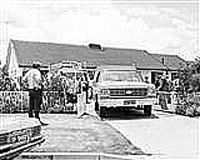
AFRICA’S GREATEST UNSOLVED MURDERS: Smits’ rented home in Springs, South Africa (Photo from flat note.co.za)
Robert Smit was running for National Party candidate in the Springs constituency. Elections were to be held on November 30, 1977. Robert and Liza had rented a house in Springs, while their children stayed home in Pretoria, South Africa’s capital.It seems clear that as Jeanne hung up, she turned to find a gun pointed at her head, and defensively raised her left hand seconds before the first shot.
On November 22, a Tuesday, Robert was at his Springs election offices. Jeanne was out during the afternoon, but the Smits’ driver, Daniel, her took her back home around 6:10 PM. Daniel testified later that he had left Mrs. Smit at 6:50 PM. At either 7:14 or 7:40 (accounts differed), Robert’s office assistant, Sarie, got a phone call from Jeanne asking if Mr. Smit was still there. He was, and Jeanne told Sarah to convey the message to Mr. Smit that “his guests are waiting for him.” It appears that Robert had made arrangements to speak to some anti-National Party voters at his home.
It seems clear that as Jeanne hung up, she turned to find a gun pointed at her head, and defensively raised her left hand seconds before the first shot. She was found slumped over the phone and autopsy showed she had been shot in the head, hand, and back. Additionally she was stabbed 14 times post mortem with a stiletto knife. The murder demonstrated “overkill,” i.e. more violence than absolutely necessary to effect the victim’s death, indicating perhaps underlying personal feelings of rage on the murderer’s part.
Jeanne appeared to have been killed 30 minutes to three hours before Robert came home. As he entered the lobby, the killer(s) fired one shot, which glanced off Robert’s neck and lodged in the wall, a second one to the chest at close range, and one to the back of the head. Lastly, he was stabbed in the back once, apparently with the same stiletto. Two different types of guns were used, according to the police, suggesting two assailants, at least.
The Smits’ bodies were not discovered until early the following morning when Daniel the driver came in for work. Spray-painted on the kitchen wall and cabinets were the strange words “RAU TEM” (click for image.)

AFRICA’S GREATEST UNSOLVED MURDERS: The bizarre spray-painted phrase in the Smits’ kitchen (Photo from Beeld/netwerk24.com)
The Suspects
A political motive has long been thought the most likely in the Smit murders. The scrawled words “RAU TEM” turned out to be Afrikaans for a specialist sub-unit of the notorious intelligence agency Bureau of State Security (BOSS), and many thought it was its murderous commander, Hendrik van den Bergh, (also called “The Tall Assassin”) who ordered the hit. However, that’s questionable, because not only was the spray painting not a typical MO of a BOSS assassination, the can of paint used actually belonged to the Smits–i.e. it was already there in the kitchen when the murder took place and was therefore unlikely to have been part of the plan.
Liza Smit points out that at the time her parents were assassinated, the political atmosphere in South Africa was fraught. The Information Scandal broke around that time, costing the jobs of the prime minister and a couple of his cabinet members. The scheme deflected funds from the defense budget to a number of pro-apartheid propaganda campaigns. Robert Smit might have had detailed detrimental information that he intended to expose after his putative election–a threat that would have been too dangerous for the implicated persons to let stand. Other conspiracy theories, too detailed to go into here, included Israel, nuclear secrets, Cuba, and a member of the security police called .
During this period, South Africa was in political turmoil. The inquest into the death of Steve Biko had begun on November 14, and a black high school student Sipho Malaza had died in police custody, the twenty-first in some 20 months, and embargoes against South Africa were beginning to mount. Against this backdrop, it’s easy to see how all kinds of people in various political camps could have ended up dead. I find the absence of the mention of the bloody apartheid era in Liza Smit’s account striking and odd, but it may reflect of how sheltered, privileged, and possibly oblivious, her life was.
However, Liza Smit recounts a story that is perhaps revelatory of the kinds of sensitivities, or lack thereof, during that era. Two days after the killings, she and her brother were brought to the Springs home–presumably by the police?–and shown the scene of the crime. The bodies had been removed, but the spattered, dried, and clotted blood was still there in all its gruesome glory. The policeman at the scene explained to Liza (remember she was only 13), “Here is where your father was shot, here is where he fell, and here are the marks where he was dragged down the passage.” I can think of a lot of cruel and unusual things, and this one takes its position high on the list.
The post AFRICA’S GREATEST UNSOLVED MURDERS appeared first on Kwei Quartey.
February 4, 2019
FREEDOM OF THE PRESS
FREEDOM OF THE PRESS: THE KILLING OF A GHANAIAN JOURNALIST
Press freedom is a precious commodity everywhere on earth. On January 16, 2019, two men on a motorbike pulled up beside a young Ghanaian reporter, Ahmed Hussein-Suale, in his car and shot him three times at close range. Ahmed died on the spot. He is the first known journalist in the world to be murdered in 2019.
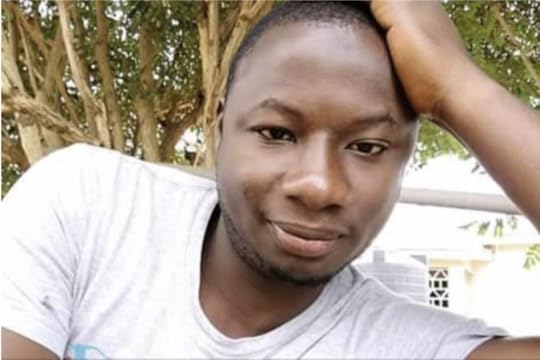
Freedom of the Press: Ahmed Hussein-Suale (Photo: BBC.com)
Ahmed worked diligently with the worldwide-known investigative journalist, Anas Aremeyaw Anas, who famously never reveals his face behind the iconic “curtain” he wears, and whose axiom is “Name, Shame, and Jail.” Ahmed was a major contributor to Anas’s exposé (in collaboration with the BBC) on corruption in the soccer world, which showed a number of high-profile Ghanaian referees and one FIFA official accepting thousands of dollars in return for match-fixing. Anas’s company, Tiger Eye PI, has exposed widespread corruption among the Ghanaian judiciary including the High Court, and has blown a number of social and political scandals wide open. President Barack Obama recognized Anas for his courageous work.

Freedom Of The Press: Anas Aremeyaw Anas (Photo: Citinewsroom.com)
Anas is the also the sort of person people hate. Kennedy Agyapong, a controversial and particularly odious minister of Ghana’s parliament, is one of Anas’s arch-enemies. Kennedy called the journalist “a blackmailer, an extortionist.” Kennedy reportedly also mimed Anas’s throat being cut and said Anas should be “hanged.” Prior to Ahmed’s death, Kennedy had mounted a relentless, foul-mouthed tirade against the young reporter on TV, radio, and social media. Kennedy, reputed to be one of Ghana’s richest people, owns a radio and TV station, which he used as a platform to demonize Ahmed. On a TV program, Kennedy showed two pictures of Ahmed, call him a “bad boy,” revealed where Ahmed lived, and encouraged people to beat him up if they saw him on the street.
The United States Embassy in Accra (Ghana’s capital) has denounced the murder, calling for a thorough investigation and stating, “This was not only an attack on Suale, but on Ghana’s climate of transparency, democratic credibility, and press freedom.” According to Reporters Without Borders (RSF), Ghana ranked first in Africa and 23rd in the world with a 2018 World Press Freedom Index of 18.4, which is above France (Index 21.9), the UK (Index 23.3), and the USA (Index 23.7). Imprisonment of reporters in Ghana is very rare, which makes the murder of one very serious.
Why is the contract-like killing of Ahmed in “remote” Ghana so important? Because an attack on a journalist anywhere should alarm journalists everywhere. According to RSF, a total of 80 journalists worldwide were killed in 2018, up from 2017. The United States is on the list for the first time because of the shooting of four journalists at the Capital Gazette. (Two other journalists were killed elsewhere in the United States in unrelated events.) We think of the violent murder and dismemberment of Jamal Khashoggi, a dissident Saudi Arabian Washington Post columnist who steadfastly criticized the Saudi government and advocated for Saudi women’s rights. Time magazine named a group of journalists, including the murdered Jamal Khashoggi, as its person of the year for 2018, “honoring their dedicated pursuit of the truth despite a war on facts and tremendous obstacles, including violence and imprisonment.”
Kennedy Agyapong’s chilling appearance on Ghanaian TV in which he “outed” Suale and encouraged people in his neighborhood to beat him up is as dangerous as it is boorish. But let’s not forget that Donald J. Trump, who has an obsession with undermining members of the media, condoned violence perpetrated on a reporter.
In the fall of 2018, the very targets of Donald Trump’s incendiary attacks became bomb targets, including CNN, which Trump says is another “fake news” outlet.
The assassination of Ahmed Hussein-Suale reminds us that inciting words against the press by a public figure can set a tone in which violence against members of the press is tolerated. This is a reality all over the world. Journalism must not die, and journalists must have the freedom to continue telling the truth.
The notion of fact being stranger than fiction, or “art imitating life,” can be clichéd, but it does seem to happen to me and my writing quite a bit. Long before the tragedy of Ahmed occurred, I had completed the second draft of my upcoming novel (THE MISSING AMERICAN, 2020) in which an investigative journalist based on Anas (I spelled it backward: “Sana”) barely escapes assassination. Indeed, the real Anas has had so many death threats, it’s hard to keep up. The attack on journalism in a novel is all very well, but in real life it is ominous.
The post FREEDOM OF THE PRESS appeared first on Kwei Quartey.
December 24, 2018
Santa Claus Is Coming
We’re all familiar with the usual tropes of Christmas: snow, sleds, reindeers, fireplaces, and how could we possibly forget–chestnuts. But perhaps the most dominant is Santa Claus: the overweight, jolly, white-bearded, red-clad man who laughs, “Ho, ho, ho.” This gentleman supposedly lives in the North Pole and come Christmas Eve, commandeers a gift-full sled pulled by a herd of reindeer that transport Santa to various homes, where he leaves presents 
August 28, 2018
HOW TO MANAGE TWO CAREERS
HOW TO MANAGE TWO CAREERS (writing + something else)

How to manage two careers:Dr. Anton Chekhov practiced while writing (Shutterstock)
For more than two decades but particularly in the last ten years, I have written novels while practicing medicine full time. I’m certainly not the first nor will I be the last author-doctor combo. Anton Chekhov, the great Russian playwright who was also a medical doctor, said, “Medicine is my lawful wife, and literature is my mistress. When I get fed up with one, I spend the night with the other.
Other writers were/are also doctors, including Somerset Maugham, Sir Arthur Conan Doyle, Robin Cook, Michael Crichton, Abraham Verghese, Khaled Hosseini (who said his medical training was an “arranged marriage”), and others. Robin Cook, an ophthalmologist, continued practicing medicine even as he prolifically wrote his gripping medical thrillers like Coma, but Michael Crichton, on the other hand, never practiced a day in his life.

How to manage two careers: Dr. Robin Cook, an ophthalmologist, practiced while writing
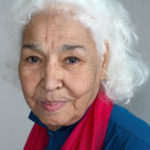
How to manage two careers:Dr. Nawad El Saawadi, a psychiatrist, wrote while practicing (Alamy Stock)
People express surprise and admiration that anyone could manage the two careers of writing and medicine. A doctor’s life can be an exhausting treadmill of night calls, early mornings, and sleep deprivation–ask the average general surgeon, cardiologist or ob-gyn. Readers of my novels have often asked me, how do you manage to write and be a doctor? When or where do you get the time? First, I didn’t become a general surgeon, cardiologist or ob-gyn! Appendicitis, heart attacks, and babies have a habit of materializing at the dead of night when you will be dragged out of bed by the summoning hospital. Secondly, fairly early on in my career, I opted out of in-hospital duty (and therefore night call) although for quite some time I did the graveyard shift at an urgent care facility. Graveyard shifts annihilated my creativity.
The reality is that most writers have a “day job” and have to manage two careers. We don’t all get to be James Patterson or JK Rowling. Even famous authors managed two careers at some point to support their “writing habit.” I’ve now retired from medicine to be a full-time writer, but over the years, I’ve come up with some tips that might be help my fellow writers to manage two careers.
How to manage two careers: 5 tips
1. Where’s your loyalty?
Using Chekhov’s marriage analogy, you will need to continually evaluate with which job your loyalty lies more. As time passes, things can change. In the beginning, you will by necessity have to be faithful to your day job while writing “on the side,” but a lucky break might transform your options.
2. Night owl–or morningbird?
What time of the day or night you write is something you must decide based on a number of factors. Is your job a classic nine to five, or is it a swing or graveyard? Are you a “night person” or do you perform best in the morning? I am mostly useless at night and prefer to rest my mind until early the next morning. You may also have young children to whom you must devote your time and attention, leaving you no choice but to snatch a couple of writing hours late at night or early in the morning before it’s time for the kids to wake up and go to school. I don’t say it’s easy! Whatever time(s) you figure out to be best, I strongly recommend that you stick to the routine as much as possible. I realize that some may have a job in which the shift changes week to week. This may be particularly troublesome because it can disrupt your creative process.
3. Stealing time
Not everyone can slip out of his/her “day job” frame of mind to writing mode, but if you can write while at work without breaking any rules, it’s worth the effort. Even if you think you can’t write in the work environment, at least give it a try a few times. Co-workers going out to lunch? Skip it. Save yourself some dough, bring a packed lunch (sandwiches are the most convenient), and use the lunch hour to get some writing done.
4. Time efficiency
Related to #3, wherever and whenever you write, it’s not only how much time you have, it’s how effectively you use it. Unfortunately, our world is rife with distractions–Facebook, Twitter, YouTube, texts, and so on. While you’re writing, try setting yourself a reasonable time during which you don’t answer emails/texts, engage in social media, or watch funny cat videos on YouTube. There are several apps like Freedom and Anti-Social that can help, if not completely eliminate, the interruptions. MS Word also has a full-screen mode in which you don’t see enticing elements popping up around the margins of your page.
Here’s something you might not have thought about. I recommend you share your writing career and how you’re doing with it freely with your co-workers –even if you experience disappointments. When people ask how your weekend was, instead of the usual conventional replies, say something about your writing–“Great weekend! I got a lot of writing done.” Curious people might ask what your book is about and express interest. Give them a quick elevator pitch–you won’t hold their attention much longer than that, anyway.
Invite your coworkers to events like your book signings and book fairs. Even if they don’t show up, they will appreciate your invitation. Involve managers and administrators too. They may be quite flattered by your gesture.
If you write a blog, ask interested colleagues if they’d like to be on your mailing list. If your workplace allows only emails related to the business, ask if you can use their personal email.
Give out “swag”–gifts like pens, coffee mugs etc. printed with an image of the jacket of your book, if you have

How to manage two careers: GOLD OR OUR FATHERS coffee mug (Kwei Quartey)
reached that stage of publication. No one can ever have enough coffee mugs. You can also give Christmas presents with your book logo or design used as a seal on the wrapping. Your co-workers will also love business cards with the book jacket design(s) on the front and your contact info and website on the reverse side.
With the above steps, I’m leading up to something. There may come a point at which you find you simply must carve out more time for your writing. Perhaps you’re approaching the publisher’s deadline or you need some extra editing time. Here is where an appeal to your coworkers, managers, and administrators for their help and understanding may be rewarded by your having been so sharing with everyone. You have them on your side and they may be more than willing to figure something out with you. Perhaps one shift on the weekend really isn’t needed. Perhaps your work on one day can be rolled over to a colleague or your assistant, if you have one. Is there someone in your office willing to cover you for a day or an afternoon? Before I left medicine permanently, my administrators worked with me to split one day’s clinic schedule between two other days, thus freeing up my Thursdays, which was a godsend.
After giving decades of life to medicine, I finally called it quits and walked out the door to give my full attention to writing. It can be scary leaving your day job and it should never be done prematurely or before you’re ready. But always imagine the day it will happen. To achieve your dream, you have to make it come alive in the panorama of your mind.
The post HOW TO MANAGE TWO CAREERS appeared first on Kwei Quartey.
July 23, 2018
RESEARCHING YOUR NOVEL
RESEARCHING YOUR NOVEL
In my novel writing, my aim is not only to entertain but also to render as authentic an experience as possible to the reader, especially since I set my detective stories in a part of the world most readers will never venture: Ghana, West Africa. Whether that location is considered “exotic” or just foreign, I try to write about it as it really is. The characters and murders are made up, of course, but even there, some content is based on real events and people. Many of the jaw-dropping fictional events in my upcoming (2019) novel THE MISSING AMERICAN, where you might say “Give me a break, that would never happen,” do exist in Ghana’s reality.

Researching your novel: Actress Lupita Nyong’o (Shutterstock)
The Missing American is a standalone novel not in the present Darko Dawson series, although there are connections with it. It introduces Mabel Safo, a Ghanaian female private investigator, whom in my fantasy could be played by the amazing Lupita Nyong’o.
MAKE YOUR SETTINGS COME ALIVE
As I set my murder mysteries in foreign locations, I like to think of setting as a character itself–something that is alive, with a personality and temperament. To do this, I need to explore and research my settings to see what they have to offer, and I always hope there’ll be a surprise around the corner.
Here are my rough guidelines for researching my novels.
Go there–in person!
Yes, we now have Google Maps and you can view a remarkable likeness of faraway land or location, but some things Google Maps can’t give you: smells, sounds, the feeling of the ground underfoot, the weather, the general ambiance. In The Missing American, a young mother witnesses two men throwing a large, mysterious bundle over the railing of the Adome Bridge, located in the town of Atimpoku in Ghana, not too far from the Akosombo Hydroelectric Dam.

Researching your novel: The Adome Bridge (Photo: Kwei Quartey)
The Adome Bridge, closed for some 6 months in 2015 for repairs, has been photographed often, and for the purposes of my novel, I could have simply described it from Internet images. But had I not visited the bridge in person, I could not have known for example that the bridge, because of its construction, flexes slightly up and down as heavy trucks pass along it. Neither would I have gotten a good sense of the height of the bridge.

Researching your novel: Southward view of Volta River from Adome Bridge (Photo: Kwei Quartey)
I had first visited Atimpoku in 2008. In 2018, I wrote the bridge scene in The Missing American from memory a few months before returning for my second visit. I found I would have to update my description of the town because during the intervening ten years, it had grown exponentially, spilling over from the west to the east bank of the Volta. I also realized I had forgotten something: there’s a toll booth at each end of the bridge. Oops. Fortunately, it won’t adversely affect my bridge scene.
Get out and explore (on foot if possible)
In addition to the bridge, I remembered from ten years ago the infamous truck stop where food vendors pounce on vehicles stopping–even slowing down–in an attempt to sell food items and soft drinks.

Researching your novel: “enthusiastic” vendors swarm a mini-bus (Photo: Kwei Quartey)
I had recalled Atimpoku’s terrain as flat, but on my second visit there, I found that really much of it is on a hillside, which is where most of the new building is taking place–all the space on low-lying land already taken up. This significantly affected a key scene in The Missing American.

Researching your novel: Hillside home construction in Atimpoku (Photo Kwei Quartey)
From near the top of the hill, one can see past the town all the way to the Volta River.

Researching your novel: Hilltop glimpse of the Volta River (Photo: Kwei Quartey)
Notice small details
What might seem like insignificant details add atmosphere and authenticity to scenes in a novel. Those who have read my stories might have noticed I make mention of two kinds of animals in Ghana: the ubiquitous goats and to a lesser extent, dogs. These animals, quintessential to both rural and urban Ghanaian life, coexist with humans but have pretty much independent, free-range lives, foraging for their own food and otherwise taking care of themselves. A dog with a collar would be an exception rather than the rule. (If I told a Ghanaian that some dogs in America get to sit at the dinner table alongside people, the reaction would be a mixture of horror and hilarity.)
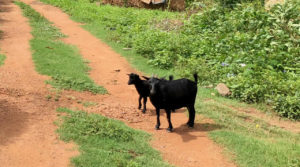
Researching your novel: Ubiquitous self-sufficient goats of Ghana. They eat everything and always appear overfed (Photo: Kwei Quartey)
Take pictures when you can–just be careful
I recommend as many photos as possible, but not all societies are equally sanguine about pic-taking. Ghanaians are more accepting of it than before and mostly pay no attention to you, probably because using a mobile is somehow less threatening from a separate camera with an obtrusive telescopic lens. In Ghana, certain areas are a no-no for photography–embassies, ministries in general and the Ministry of Defense in particular, police stations, and others. When in doubt, it’s best to ask. I confess, however, that I do sometimes use surreptitious, “ninja” photo-taking techniques.

Researching your novel: “Unauthorized” photo of the CID crime scene van (Photo: Kwei Quartey)
Seek out the rougher parts of town
Especially if you write crime fiction, find the wretched parts of your settings (if you can do it safely) because wretchedness and seediness are often vital and fascinating components of a novel. In my writing, I like to contrast the gritty with the opulent, and in Ghana, there is much of that contrast, as shown in the following photos.

Researching your novel: Tough, bustling neighborhood of Nima, Accra (Photo: Kwei Quartey)

Researching your novel: Pristine grounds at the Royal Senchi Hotel, a lap of luxury (Photo: Kwei Quartey)
Most important, keep your writer mind open to the unexpected. You might have plotted your novel in a certain way and when you get to the real-life setting you discover it just wouldn’t work in practice. For instance, in The Missing American, I thought two villages on the map were fairly close, but when I did the actual journey, they were much too far apart in real life for one of my plot points to work. In the end, it turned out better, so there’s often a silver lining when you discover you’re wrong about a particular detail. You can even incorporate that into the story, i.e. your protagonist might say, “I didn’t realize the two villages were so far apart. Mr. X couldn’t have murdered Mr. Y and then returned home in time for the six o’clock news. Unless . . .”
Finally, don’t forget to put in passersby and random sights, especially those that warm your heart.

Researching your novel: Best friends forever (Photo: Kwei Quartey)
The post RESEARCHING YOUR NOVEL appeared first on Kwei Quartey.
June 30, 2018
THE CURSED POOR:MEDICINE IN A WEST AFRICAN COUNTRY
A GLIMPSE INTO THE PRACTICE OF MEDICINE IN A WEST AFRICAN COUNTRY
The West African country of Ghana continues to show respectable GDP growth rates.
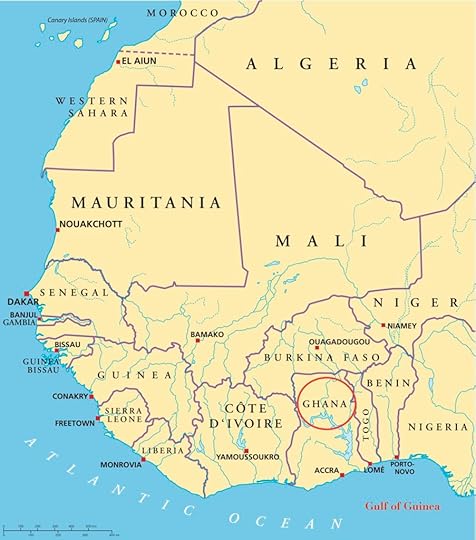
West African country of Ghana sits centrally on the Gulf of Guinea
Yet multiple studies show that Ghana’s income inequality rate continues to accelerate. Talk about the 1% movement–in Ghana, the income gap between rich and poor is so severe it would be more like the zero point something percent. An ordinary citizen interviewed by a local radio station in Accra said he didn’t know what GDP was and he was shocked that Ghana’s was one of the better ones on the continent, because it sure didn’t feel like it.
An area where this inequality is evident is in medical care. Private healthcare facilities are associated with shorter wait times and increased patient satisfaction, but they are expensive and accessed only by those with money. The National Health Insurance Scheme, which is supposed to help the poor pay for medical care, has failed to fulfill its mandate and, ironically, wealthy people are more likely to enroll.
I had the opportunity to personally see medical care in action in Accra (the capital of Ghana) when the sister of a friend of mine–we’ll call them “Mary’ and “Jason” respectively for the purposes of this blog post–was in a bad vehicle crash when the wheel of a tro-tro (public minivans transporting 14-18 passengers) came off while the tro-tro was traveling at top speed. Mary suffered a severe pelvic fracture, multiple rib fractures, and a punctured spleen. Miraculously, she was brought to the trauma ward at the Military Hospital, one of Accra’s better public hospitals. “Miraculously” because emergency services (ambulances, fire, etc.), although improving, are still sluggish in arriving.
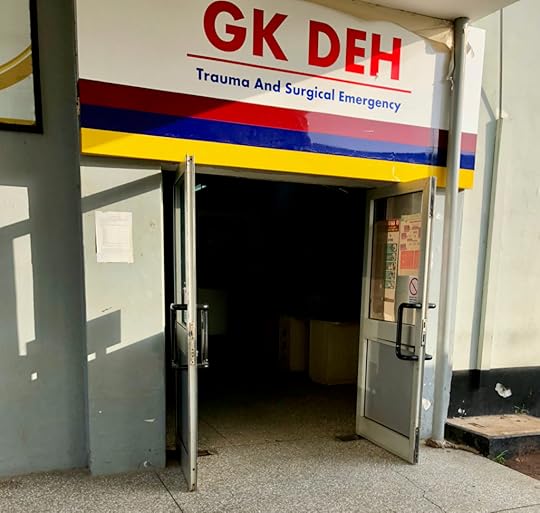
Trauma ER at Military Hospital (Medicine in a West African country)
To stop internal bleeding, she went straight to surgery for a life-saving splenectomy, and from there she was admitted to the ICU. I had not arrived in Ghana while Mary was in the ICU, but Jason relates that the care was of high quality, and I have seen a comparable ICU elsewhere in Accra and it was up to international standards. However, the cost of care in the ICU was the equivalent of about $170 a day, and that was just the base rate. Mary was in the ICU for 10 days, so a total of $1700.
You will be shocked to learn that many items like IV fluids and certain essential medications used during ICU care must be purchased on a daily basis by the patient’s family members. The items are generally written out on a prescription form in the morning and the family must obtain them either at the Military Hospital pharmacy or, if unavailable there, elsewhere at outside pharmacies. Here is an example of one such prescription for Mary:
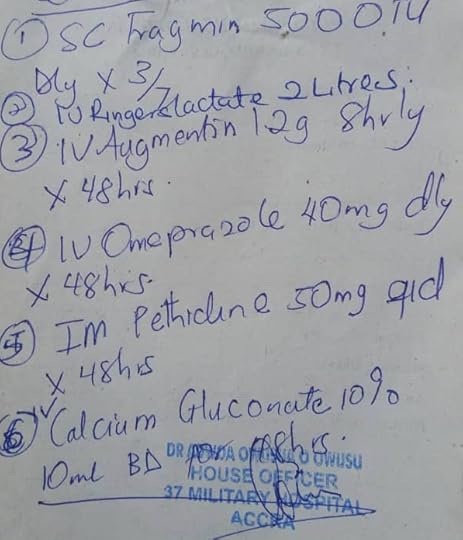
Rx for IV fluid and medications (Medicine in a West African country)
As an example, the first item, Fragmin, is vital to prevent deep vein thrombosis (DVT), which Mary was at high risk of developing because of the pelvic fractures and her immobile state. A 6-day supply cost about $200. It had to be given for Mary’s entire stay in the hospital in the ICU and then the ward, which was a little over 3 weeks, i.e a total of $700. Also expensive was Pethidine (called Mepiridine in the US and not used much anymore) was for pain, which as you can imagine, was intense. I saw Mary’s pelvic film and CT scan and it looked like a jigsaw puzzle of fractures. (The CT scan was done at a private facility as the hospital’s CT and MRI were both down.) The other items are IV fluid, antibiotic, and anti-ulcer medications. Bear in mind that all the items may not be available at one pharmacy. Jason had to obtain many of these items either daily or every other day, meaning a lot of going around town to find pharmacies that stocked them–sometimes as many as five or six different places.

Maneuvering the gurney into the ultrasound room (Medicine in a West African country)
When Mary moved to the ward, doctors ordered a doppler ultrasound of her swollen left leg. Moving her was an exercise in torture because of her 10/10 level of pain, and my suggestion that they premedicate her was dismissed. The radiology waiting area was pretty packed, and the ultrasound room was oddly almost too small to easily accommodate a gurney.

Patients patiently waiting (medicine in a West African country)
As in many hospitals in the UK (still), the wards contain several beds per large room. This obviously reduces privacy considerably, and it’s also upsetting for patients when a fellow patient dies, because it becomes quite obvious even when curtains are drawn around his or her bed. Males and females are not segregated. Very curious to me was that medications, once obtained, were generally kept at the patient’s bedside, and that included opioids like codeine. However, that needs to be seen in context, since cough medications with codeine are available without a prescription. Incidentally, Ghana has its own opioid crisis with Tramadol abuse.

Family members at a patient bedside on the ward (medicine in a West African country)
You might notice a floor-standing fanat the foot of one of the hospital beds. That belongs to a patient. There is no air-conditioning and if you want to be cooled off, especially during the sweltering heat of the day, you need to have relatives bring in your own fan. You might be the envy of other patients, though!
The happy ending to this saga is that Mary survived, is out of the hospital and ambulating with the help of a walker. The bill for the ward stay was equivalent to $1880. Add that to the ICU bill of $1700 and you have $3580. Don’t forget also the massive bill for the medications and IV fluids. This is a lot of money in Ghana and it is cash. Forget about credit cards, my friends. The point is that if Jason and family had not been able to come up with these kinds of funds, the outcome for Mary might have been very different, up to and including death. By the way, if you can’t pay your final bill, you can’t leave the hospital and the bill will continue to accrue. I have no idea what the endpoint of such an intractable situation would be.
The post THE CURSED POOR:MEDICINE IN A WEST AFRICAN COUNTRY appeared first on Kwei Quartey.
April 11, 2018
A GIFT FOR NATIONAL LIBRARY WEEK
April 8 – 14, 2018 is National Library Week. The information and techno age notwithstanding, libraries still perform an essential function in the education and leisure time of both children and adults, and they are very important to us authors as well.
To celebrate, I felt like giving a gift to someone–anyone! A clever item caught my eye a couple of weeks ago while reading the New York Review Of Books. I couldn’t resist it and I’m pretty sure a lot of book lovers won’t be able to either.
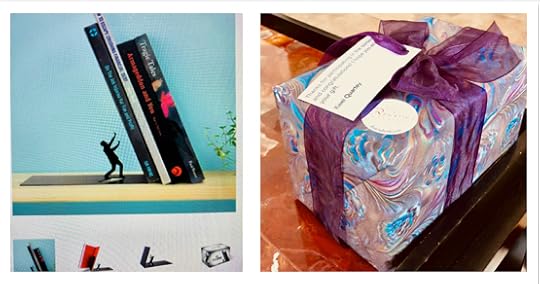
The End Bookend: stop the apocalypse. Beautifully wrapped just for you
This nifty gift can easily be yours if you’re the first one to answer this simple question:
In the Inspector Darko Dawson series, what is the correct medical name for the heart condition Darko’s son Hosiah has?
Send your answer to kweiquartey@gmail.com. First one in my inbox by timestamp wins!
Good luck!
The post A GIFT FOR NATIONAL LIBRARY WEEK appeared first on Kwei Quartey.


